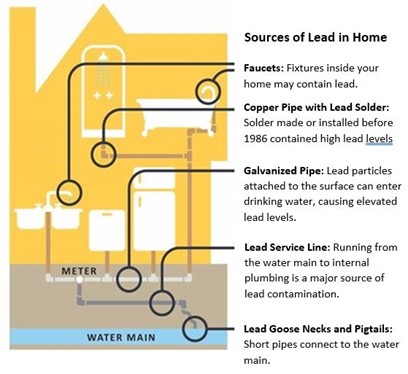Drinking Water Protection
- Drinking Water Protection Home
- About Us
- A-Z Index of Contaminants in Water
- Community Public Water Supply
- Drinking Water Grants and Loans
- Drinking Water Institute
- Drinking Water in Schools and Child Cares
- Drinking Water Revolving Fund
- Laws and Rules
- Noncommunity Public Water Supply
- Source Water Protection
- Water Operator and Certification Training
- Drinking Water Protection Contacts
Related Topics
- Annual Reports
- Drinking Water Risk Communication Toolkit
- Drinking Water Protection External Resources
- Fact Sheets
- Forms
- Invisible Heroes Videos: Minnesota's Drinking Water Providers
- Noncom Notes Newsletter
- Sample Collection Procedures (videos, pictures, written instructions)
- Waterline Newsletter
Related Sites
- 10 States Standards
- Clean Water Fund
- Health Risk Assessment – Guidance Values and Standards for Water
- Minnesota Well Index
- Water and Health
- Wells and Borings
Environmental Health Division
Lead in Drinking Water in Head Start Program Settings
Lead is a toxic metal commonly found in air, soil, dust, food, drinking water, and in products such as lead based paint. There is no safe level for lead in the body. Reducing levels of lead in drinking water is an important part of reducing the overall exposure to lead.
As a provider of Head Start services for Minnesota’s children, you value their healthy development. Awareness of environmental concerns and actions that you can take to reduce adverse effects can help make a quality experience.

Head Start programs must meet state and federal criteria regarding lead testing and mitigation. Currently public schools, charter schools and child care centers in Minnesota are required to test for lead. Testing is voluntary at the state level for family/home child care providers. For child care providers, more information can be found at Lead in Drinking Water in Child Care Settings.
Testing for lead in drinking water can help you demonstrate that you have met both state and federal monitoring protocols for Head Start Programs.
Federal Requirements
A program must develop a plan to prevent children from being exposed to lead in water and paint in Head Start facilities. In facilities where lead may exist, a program must implement ongoing practices, including testing and inspection at least every two years, with support from trained professionals. As needed, a program must pursue remediation or abatement to prevent lead exposure.
- The federal Office of Head Start Policy and Regulations include memo ACF-IM-HS-23-01 which requires that Head Start Programs have a plan to test for lead.
Minnesota Department of Health (MDH) Recommendations
Head Start programs test for lead in drinking water as part of their preventative maintenance and lead inspections.
- Use either the Environmental Protection Agency (EPA) 3Ts guidance or use the MDH Model Plan.
- MDH Model Plan: Provides resources on developing testing programs. Testing every two years to meet the federal requirement will also meet the state requirement (state requires testing once every 5 years).
- Identify and test all taps used for drinking and food preparation.
- Minimize exposure to lead and maintain your drinking water quality.
- Take action to reduce lead exposure whenever a test reveals the presence of lead.
- Communicate about lead testing results with staff, and community. This toolkit provides resources for Head Start providers to communicate about lead in drinking water test results with the families they serve.
Every Head Start facility is unique. Some programs may need to conduct their own testing while other programs that use space in a public or charter school may need to request a copy of lead testing results for their records from the school.
Head Start programs are eligible for free lead in drinking water testing from the Water Infrastructure Improvements for the Nation (WIIN) Grant. More information can be found at Minnesota Lead Testing in Schools and Child Cares in Drinking Water.
Resources
Environmental Protection Agency (EPA)
- Ensuring Drinking Water Quality in Child Care Facilities During and After Extended Closures (PDF)
- 3Ts for Reducing Lead in Drinking Water
Department of Health (MDH)
- Lead in Drinking Water in Child Care Settings (PDF)
- Choose Safe Places Minnesota
- Lead Poisoning Prevention - Homeowner Information:
Information on reducing hazards from lead such as paint, and how to hire a licensed contractor.
Department of Education (MDE)
HeadStart.gov
Go to >top.